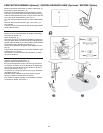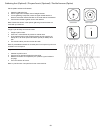
- 37 -
One-step Buttonhole Sewing / Costura De Ojales De Un Paso
Coudre Une Boutonnière En Une Étape
Buttonhole sewing is a simple process that provides reliable results. However, it is strongly suggested to always make a
practice buttonhole on a sample of your fabric and interfacing.
Making a Buttonhole
1.
Using a tailor’s chalk, mark the position of the buttonhole on the fabric.
2. Attach the buttonhole foot and set the pattern selector to “T”. Set the stitch length dial between “0.25” and “1” . Adjust
the stitch width dial to desired width between “4” - “5”.
3. Lower the presser foot aligning the marks on the foot with the marks on the fabric. (Fig. A) The front bar tack will be sewn
first.
4. Open the button plate and insert the button. (Fig. B)
5. Lower the buttonhole lever and gently pull forward. (Fig. C)
6. While lightly holding the upper thread, start the machine.
7. Buttonhole stitching is done in the order shown in Fig. D.
8. Stop the machine when the buttonhole is sewn.
Making a Buttonhole on Stretch Fabrics (Fig. E)
When sewing buttonholes on stretch fabric, hook heavy thread or
cord under the buttonhole foot. When the buttonhole is sewn,
the stitches will overcast the cord.
1.
Mark the position of the buttonhole on the fabric with the tailor’s chalk and attach the buttonhole foot. Set the pattern
selector to “T”. Set the stitch length dial between “0.25” and “1”.
2. Hook the heavy thread onto the back end of the buttonhole foot, then bring the two heavy thread ends to the front of the
foot. Insert them into the grooves and temporarily tie them there.
3. Lower the presser foot and start sewing. Set the stitch width to match the diameter of the gimp thread.
4. Once sewing is completed, gently pull the heavy thread to remove any slack and then trim off the excess.
Coser ojales es un proceso sencillo que proporciona resultados satisfactorios. Sin embargo es recomendable realizar siempre
un ojal de muestra en un trozo de tela auxiliar.
Confección de un ojal
1.
Con una tiza de sastre, marcar la posición del ojal en la tela.
2. Coloque el pie prénsatela para ojales y ponga el dial selector de dibujo en “T”. Ponga el selector de largo de puntada en
el ancho deseado.
3. Baje el pie prensatela alineando las marcas del pie prensatela con las marcas en la tela. (Fig. A) (Se coserá primero el
hilvanado de la barra frontal.)
4. Abra la placa del botón e insértelo. (Fig. B)
5. Baje la palanca para hacer ojales y empújela suavemente hacia atrás. (Fig. C)
6. Mientras se sujeta ligeramente el hilo superior, dé arranque a la máquina.
7. La costura del ojal se realiza de acuerdo a la secuencia indicada en Fig. D.
8. Pare la máquina cuando haya terminado de coser el ojal.
Confección de un ojal en tejidos elásticos (Fig. E)
Para coser un ojal en tejidos elásticos, enganche un hilo grueso o cordel bajo el prénsatelas de ojales. Cuando el ojal haya
sido cosido las colas del cordel sobrepasarán el ojal.
1.
Marque la posición del ojal en la tela con la tiza de sastre, ponga el prénsatelas para ojales y coloque el disco selector
del dibujo en “T”. Pongo el selector de largo de puntada en “0.25” y “1”.
2. Enganche el cordel en el extremo posterior del prénsatelas para ojales, lleve los dos extremos del cordel a la parte frontal
del prénsatelas, insértelos en la ranuras y fíjelos provisoriamente.
3. Baje el prénsatelas y comience a coser. Ajuste el ancho de la puntada de modo que coincida con el diámetro del cordel.
4. Una vez terminado de coser, tire suavemente del cordel para eliminar cualquier aflojamiento y luego recorte el sobrante.
Changer le pied.
Régler la machine comme indiqué "T".
1.
Marquer la position de la boutonnière sur le tissu.
2. Positionner le pied sur la marque, abaisser le pied. (Fig. A)
3. Ouvrir la plaque de boutonnière et introduire le bouton. (Fig. B)
4. Abaisser le levier de boutonnière et tirer vers l'arrière. (Fig. C)
5. Tenir légèrement le fil supérieur et démarrer la machine.
6. Coudre la boutonnière. (Fig. D)
7. Arrêter la machine à la fin de la boutonnière.
Couture d'une boutonnière sur un tissu élastique (Fig. E)
Un file de soutien est nécessaire pour les boutonnières sur tissus élastiques.
1.
Préparation comme mentionné plus haut.
2. Poser le fil de soutien à l'arrière du pied et tirer vers l'avant les deux extrémités du fil, les fixer dans la rainure et nouer les
bouts.
3. Abaisser le pied et coudre la boutonnière. Adapter la largeur du point à l'épaisseur du tissu.
4. Quand la boutonnière est terminée, tirer légèrement le fil, fixer et découper es surplus.


















